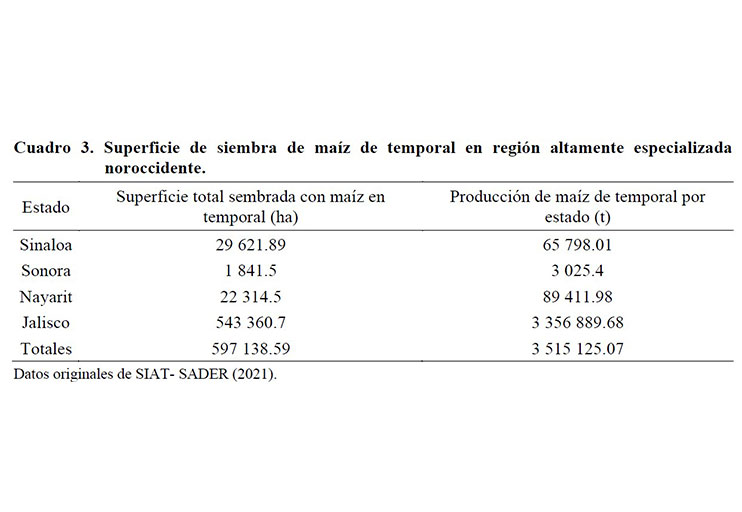Creation of agricultural regions highly specialized in the cultivation of corn Case study: Sinaloa, Sonora, Nayarit and Jalisco
DOI:
https://doi.org/10.29312/remexca.v14i2.3421Keywords:
high specialization, regions, staple cropsAbstract
The creation of regional areas highly specialized in the production of a staple crop is an agricultural policy mechanism that facilitates the increase in production and productivity of land, by attracting greater quantities of sellers of agricultural inputs to the region, which causes obtaining inputs at wholesale prices, incorporation of technology by incorporating improved inputs and fertilizers, which should lead to the reduction of unit costs of the product, exchange of knowledge between producers about cultivating the agricultural product and greater management power to place the product they generate on the market. The procedure to be followed to generate a highly specialized region requires to be carried out in steps in time, in this case it is proposed to enhance production in the irrigation area of the region and then, a year or an agricultural cycle later, design measures to activate the rainfed producers in the same area, with the assurance that there will be previous results that help to polish the strategy of incorporation of the owners of rainfed lands, who, even from the activation stage of the irrigation areas, will have already had some benefits and incentives given by the greater presence of sale of inputs of lower prices as an effect of what was achieved in the first stage of the project with the producers who have irrigation for the crop.
Downloads
References
CEDRSSA. 2020. Centro de Estudios para el Desarrollo Rural Sustentable y la Soberanía Alimentaria (CEDRSSA). Las regiones de México: desigualdades y potencial para alcanzar su seguridad alimentaria. Universidad Nacional Autónoma de México (UNAM). México, DF. 151-202 pp. CIMMYT. 2019. Centro Internacional de Mejoramiento de Maíz y Trigo (CIMMYT). Maíz para México, plan estratégico 2030. CIMMYT. El Batán, Estado de México. 25-35 pp. https://repository.cimmyt.org/bitstream/handle/10883/20219/60937.pdf.
Olivares, B. O.; Hernández, R. A. A.; Molina, J. C. y Pereira, Y. 2018. Zonificación agroclimática del cultivo de maíz para la sostenibilidad de la producción agrícola en Carabobo, Venezuela. Revista Universitaria de Geografía, Venezuela. 27(2):135-156. http://www.scielo.org.ar/pdf/reuge/v27n2/v27n2a06.pdf. OXFAM. 2018. Oxford Committee for Famine Relief (OXFAM). El derecho a la alimentación en México: recomendaciones de la sociedad civil para una política pública efectiva. OXFAM-México. 73-80 pp. http://www.cedrssa.gob.mx/files/10/26Las%20regiones%20de%20M% C3%A9xico:%20desigualdad%20y%20potencial%20para%20alcanzar%20su%20seguridad%20alimentaria.pdf. SADER. 2022. Secretaría de Agricultura, Ganadería, Desarrollo Rural, Pesca y Alimentación (SADER). Balanza disponible de consumo maíz blanco. México, DF. 1-6 pp. https://www.gob.mx/cms/uploads/attachment/file/622613/balanza-disponibilidad-consumo-6.pdf. SADER-SIAP. 2021. Secretaría de Agricultura, Ganadería, Desarrollo Rural, Pesca y Alimentación-Servicio de Agroalimentaria y Pesquera (SAGARPA-SIAP). Superficie sembrada y producción por estados. https://nube.siap.gob.mx/avance-agricola/.

Published
How to Cite
Issue
Section
License
Copyright (c) 2023 Revista Mexicana de Ciencias Agrícolas

This work is licensed under a Creative Commons Attribution-NonCommercial 4.0 International License.
The authors who publish in Revista Mexicana de Ciencias Agrícolas accept the following conditions:
In accordance with copyright laws, Revista Mexicana de Ciencias Agrícolas recognizes and respects the authors’ moral right and ownership of property rights which will be transferred to the journal for dissemination in open access. Invariably, all the authors have to sign a letter of transfer of property rights and of originality of the article to Instituto Nacional de Investigaciones Forestales, Agrícolas y Pecuarias (INIFAP) [National Institute of Forestry, Agricultural and Livestock Research]. The author(s) must pay a fee for the reception of articles before proceeding to editorial review.
All the texts published by Revista Mexicana de Ciencias Agrícolas —with no exception— are distributed under a Creative Commons License Attribution-NonCommercial 4.0 International (CC BY-NC 4.0), which allows third parties to use the publication as long as the work’s authorship and its first publication in this journal are mentioned.
The author(s) can enter into independent and additional contractual agreements for the nonexclusive distribution of the version of the article published in Revista Mexicana de Ciencias Agrícolas (for example include it into an institutional repository or publish it in a book) as long as it is clearly and explicitly indicated that the work was published for the first time in Revista Mexicana de Ciencias Agrícolas.
For all the above, the authors shall send the Letter-transfer of Property Rights for the first publication duly filled in and signed by the author(s). This form must be sent as a PDF file to: revista_atm@yahoo.com.mx; cienciasagricola@inifap.gob.mx; remexca2017@gmail.
This work is licensed under a Creative Commons Attribution-Noncommercial 4.0 International license.


